|
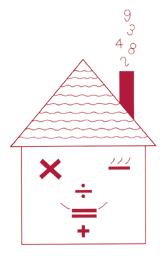
Math in the Home
Your home is full of opportunities to explore math with your child and, at the same time, build his or her self-confidence and understanding of mathematical ideas. This is a chance for you and your child to "talk math" that is, to communicate about math while discovering relationships between numbers. Being able to describe mathematical patterns and relationships, such as those between "addition and subtraction" or "odd and even numbers," is important to later success in math.
The activities in this section are intended to be enjoyable and inviting and use items that can be found in your home. While doing the activities, keep in mind that an understanding of math and a sense that math is enjoyable will help children develop skills that they will need for success their entire lives.
Fill It Up (Grades K-2)
What you'll need:
A measuring cup, 4 glasses of equal size, and water
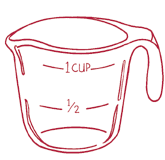
- Pour water at different levels ( 1/3 cup, 1/2 cup, 3/4 cup and 1 cup) in each glass. Put the glasses next to each other. Ask your child: Are all the water levels the same or different?
- Ask your child questions to encourage comparison, estimation, and thinking about measurement. Which glass has more water? Which has less? How many glasses of water do you estimate it will take to fill the container?
- Pour more water into one of the glasses to make it equal to the amount of water in another glass. Move the glasses around so that the glasses that have the same amount of water are not next to each other. Ask your child: Which glasses do you think have the same amount of water?
- As your child begins to understand more, do activities using different-shaped containers that hold the same amount of a substance (water, rice, and popcorn kernels). This helps your child see comparisons, as well as the various capacities of different-sized and -shaped containers.

Parent Pointer - Filling empty containers provides opportunities to explore comparisons, measurement, volume, estimation, and geometry. |
Fractured Fractions (Grades K-3)
What you'll need:
Clear container, masking tape, marker, measuring cups ( 1/2, 1/3, or 1/4 cup measure), uncooked rice or popcorn kernels, and water
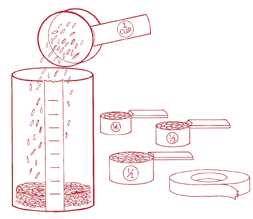
- Have your child stick a piece of masking tape straight up one side of the clear container from the bottom to the top.
- For younger children, use a 1/2 cup measure. For older children, use a 1/3 or 1/4 cup measure. Choose the unit of measure and fill the measuring cup. Then let your child pour the substance from the measuring cup into the clear container. Continue to pour the same amount of the substance into the container.
- As each equal amount of the substance is poured, mark the level on the container by drawing a line on the tape. Write the cup size or appropriate fraction on each line. The fraction for one-third cup would be 1/3.
- Follow this procedure until the container is full and the tape is marked in increments to the top of the container.
- Fill the container again and again using different measures each time. Ask your child "thinking" questions
- How many whole cups do you think this container will hold? How many 1/2 cups, 1/3 cups, or 1/4 cups do you think the container will hold?
- How many 1/2 cups equal a cup?
- How many 1/4 cups equal 1/2 cup? A cup?
- How many 1/4 cups equal 3/4 cup?
Parent Pointer - This hands-on activity explores whole numbers and fractions by using measurements your children can see. Your children also will learn to guess or estimate quantities. |
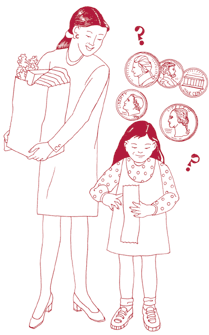 Money's Worth
Money's Worth (Grades 1-3)
What you'll need:
Coins, grocery store coupons, and a pencil
- Coin clues. Ask your child to gather some change in his or her hand without showing what it is. Start with amounts of 25 cents or less (for first-graders, you can start with pennies and nickels). Ask your child to tell you how much money and how many coins there are. Guess which coins are being held. For example, "I have 17 cents and 5 coins. What coins do I have?" (3 nickels and 2 pennies).
- Clip and save. Cut out grocery store coupons and tell how much money is saved with coins. For example, if you save 20 cents on detergent, say 2 dimes. Ask your child what could be purchased using the savings from the coupon. A pack of gum? A pencil? How much money could be saved with 3, 4, or 5 coupons? How could that money be counted out in coins and bills? What could be purchased with those savings? A pack of notebook paper? A magazine? How much money could be saved with coupons for a week's worth of groceries? How would that money be counted out? What could be purchased with those savings? A book? A movie ticket? What percentage of the original price is the coupon worth?
- Count the ways. How many ways can you make 10 cents, 25 cents, 30 cents, 40 cents, or 50 cents? You can help your child add the coins in various ways to get different answers.
- Try playing the coin games with coins from another country.
Parent Pointer - Coin games help children to learn the value of coins. They also teach counting, addition, subtraction, and multiplication. Coupons can help teach children money management, as well as subtraction and percentages. |
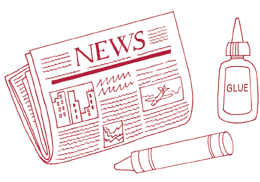 In the News
In the News (Grades K-2)
What you'll need:
Newspaper, scissors, pencil or crayon, glue, and graph paper
- Newspaper numbers. Help your child look for numbers 1 to 100 in the newspaper. Cut the numbers out and glue them in numerical order onto a large piece of paper. For children who cannot count to 100 or recognize numbers that large, only collect up to the number they do know. Have your child say the numbers to you and practice counting up to that number.
- OR, do this: Collect only numbers within a certain range, like the numbers between 20 and 30. Arrange the numbers on a chart, grouping all the numbers with 2s in them, all the numbers with 5s, and so on.
- Counting book. Cut out pictures from the newspaper and use them to make a counting book. Page 1 will have one thing on it, page 2 will have 2 things that are alike, page 3 will have 3 things that are alike, and so on. All the things on the each page have to be the same. At the bottom of each page, write the number of items on the page and the word for the item. Have your child tell you a story about what is on the page.
Parent Pointer - This newspaper activity helps children read and understand numbers and charts. |
Math Activities for Grades K-5:
|
|
|